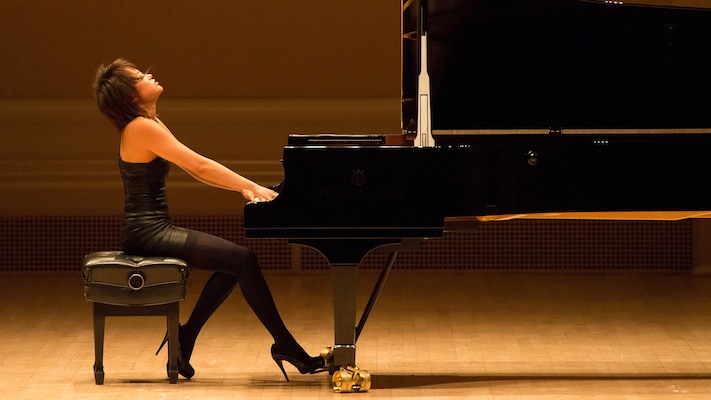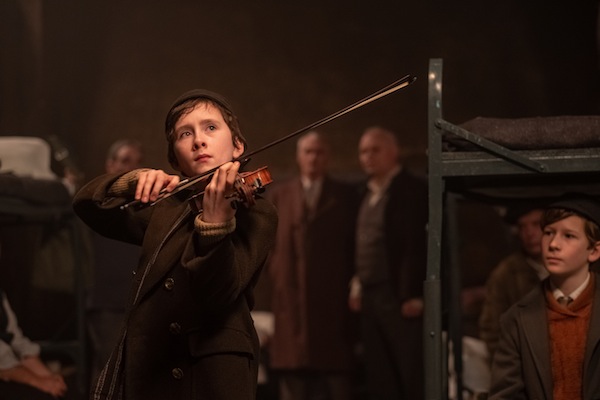
Month: December 2019
How China Made the Piano Its Own
 Yuja Wang, courtesy of Medici TV
Yuja Wang, courtesy of Medici TV
This is a first—I can’t ever remember reading an article in The Economist that brought tears to my eyes… . The article in question is, to use academic terminology, a “reception history” of the piano in Chinese culture from the mid-19th century to the present. Here’s the vignette from China’s 1966-1976 “Cultural Revolution” that brought out my handkerchief:
Lu Hong’en, the conductor of the Shanghai Symphony, was thrown into a cell. He continued to hum Beethoven there. After he tore up a copy of Mao’s “Little Red Book,” he was sentenced to death. Lu told a fellow prisoner: “If you get out of here alive, would you do two things? Find my son, and visit Austria, the home of music. Go to Beethoven’s tomb and lay a bouquet of flowers. Tell him that his Chinese disciple was humming the Missa Solemnis as he went to his execution.” Lu was shot within days. His cellmate reached the Viennese grave three decades later.
You will have to read the rest of the article for yourself, here (you probably will have to register to read five free articles a month). I consider this article to be required reading for cultural literacy in classical music in today’s world. The author or authors point out that China is not only turning out star performers (such as Yuja Wang, pictured above); the creation in China of music for the piano has reached critical mass.
The one caveat or clarification I want to offer is that the article states, without elaboration, that the state-run piano company Pearl River (the world’s largest producer) “builds for Steinway.” That statement is, in my opinion, accurate; but also, potentially very misleading. Pearl River does not make Steinway pianos, or even parts or components for Steinway pianos.
What is going on here is that the Steinway company wants its dealers also to be able to offer pianos that are more affordable. Pianos with, if perhaps not Steinway’s imprimatur, at least their nihil obstat. Those brands are the “Boston” and “Essex” pianos. The Essex pianos are “designed by Steinway” and sold by Steinway, but manufactured in China by Pearl River.
The linked-to article also includes an embedded playlist of relevant music and performances, which in and of itself is a reason to click through.
# # #
“The Song of Names” (film)

Center: Dovidl (played by Luke Doyle)
© Sabrina Lantos. Courtesy Sony Pictures Classics.
Classical-music fans, especially fans of the violin and its literature, will want to know about the upcoming (opening in selected cities December 25, 2019; nationwide in January) big-screen theatrical release of the film The Song of Names, based on Norman Lebrecht’s prize-winning novel of the same name. The director is François Girard (The Red Violin, Thirty Two Short Films About Glenn Gould); for that reason we can have a high degree of confidence that great care has been taken in getting the musical details right. But all that is not to say that people whose primary musical orientation is other than classical will not also appreciate the film. The plot is compelling, the characters are intriguing, the cinematography is atmospheric, and the film score is by Howard Shore, of Lord of the Rings fame.
Here’s what the film’s US distributor Sony Pictures Classics says about the setup of the film’s action, much of which is told in flashbacks:
Martin Simmonds (Tim Roth) has been haunted throughout his life by the mysterious disappearance of his “brother” and extraordinary best friend, a Polish Jewish virtuoso violinist, Dovidl Rapaport, who vanished shortly before the 1951 London debut concert that would have launched his brilliant career. Thirty-five years later, Martin discovers that Dovidl (Clive Owen) may still be alive, and sets out on an obsessive intercontinental search to find him and learn why he left.
What interests me most, of course, is how successful the production crew has been at allowing the audience to suspend disbelief and accept that the actors on screen are actually playing the violin. Based on what I have seen, I think they have done a very impressive job. Further explanation, the trailer, and a mini-feature on the teenage actor who is also a genuine violin virtuoso, after the jump.
Tenebrae Choir: “Miserere mei, Deus” (Allegri)
Gregorio Allegri’s “Miserere” (Have mercy on me, Lord) is one of the most famous pieces of Late-Renaissance polyphonic a cappella choral music. Either despite or perhaps because of its difficulty, it is also one of the most frequently-recorded pieces of sacred music. The linked-to Wiki gives an excellent overview, so I encourage you to read it. In an interesting historical synchronicity, the most often-cited date for Allegri’s composition of the “Miserere” is 1638, the same year in which Roger Williams (the English lawyer and divine; not the 1950s-1960s lounge pianist) co-founded The First Baptist Church in America. Which was about as distant as one could get (at least within European civilization) from the creation of the “Miserere,” both geographically and culturally.
Another famous synchronicity or at least connection is that while on a tour of Italy, the 14-year old Wolfgang Amadeus Mozart visited the Vatican and heard the “Miserere” on a Wednesday and wrote it down from memory. He returned on Friday to check his work. Given that the “Miserere” had been the “secret piece” of the Sistine Chapel choir, one might have feared for the young Mozart. But, in the event, Pope Clement XIV was a good sport about it, later summoning Mozart to receive the Order of the Golden Spur. It is through the young Mozart’s sharing his work with colleagues that the piece became known throughout Europe; Liszt and Mendelssohn both transcribed it.
There is no shortage of very good performances of this work, and quite a few great performances. I am posting this particular video because it is (by far) the best performance video I have seen; indeed, it is slugged as “A Film by Jon Coates.” The singing is truly extraordinary. However, the pedant within me wishes to point out that in view of what I call “Musical Pitch Inflation” over the past 400 years, I think the consensus of scholars today is that the actual pitch that the solo singer in Mozart’s time sang at the climaxes would, on a modern piano, be a High B, not a High C. And I for one would have no problem with an historically pitch-correct performance.
# # #


